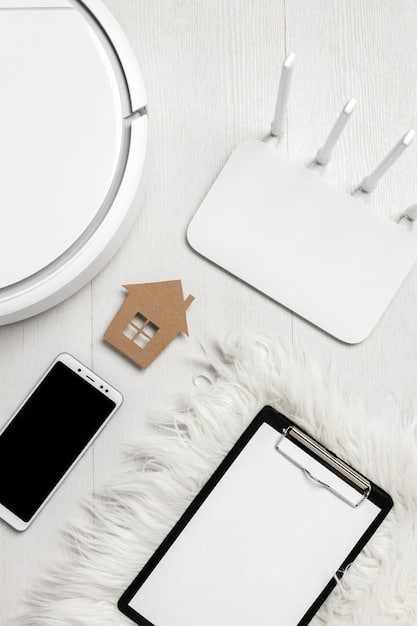Smart Home Integration: Seamless Control of Your Devices

Smart home integration connects all your smart devices into a single, unified system, allowing you to control and automate your home’s functions seamlessly, enhancing convenience, security, and energy efficiency.
Imagine controlling your lights, thermostat, security system, and entertainment center with a single tap on your smartphone or a simple voice command. Smart home integration makes this a reality, transforming your house into an intelligent and responsive living space.
Understanding Smart Home Integration
Smart home integration is more than just having a collection of smart devices; it’s about creating a cohesive ecosystem where these devices work together seamlessly. This integration allows you to automate tasks, monitor your home remotely, and enjoy a level of convenience and control previously unimaginable.
This concept involves connecting various devices and systems within your home, such as lighting, heating, security, entertainment, and appliances, onto a unified network. This network enables these devices to communicate with each other and be controlled remotely through a central hub, such as a smartphone app, voice assistant, or dedicated control panel.
Benefits of Smart Home Integration
Integrating smart devices offers numerous advantages that can significantly enhance your lifestyle and home environment. Here are some key benefits:
- Enhanced Convenience: Control multiple devices with a single app or voice command.
- Increased Security: Monitor your home remotely and receive alerts for unusual activity.
- Improved Energy Efficiency: Automate energy usage based on your habits and preferences.
- Personalized Comfort: Customize your home environment to match your mood and needs.
In conclusion, smart home integration provides a comprehensive approach to home automation, increasing comfort, security, and efficiency. By understanding its core concepts and benefits, you can take the first steps towards transforming your living space.
Choosing the Right Smart Home Ecosystem
Selecting the right smart home ecosystem is a critical first step in setting up your integrated smart home. Different ecosystems, like Amazon Alexa, Google Assistant, and Apple HomeKit, offer varying levels of compatibility, features, and user experiences.
This decision will influence which devices you can seamlessly integrate and how well they will work together. Consider factors such as your existing devices, your preferred voice assistant, and your privacy concerns when making your choice.

Popular Smart Home Ecosystems
Here’s a brief overview of some of the most popular smart home ecosystems:
- Amazon Alexa: Known for its wide device compatibility and robust voice control capabilities.
- Google Assistant: Integrates seamlessly with Google services and offers excellent voice recognition.
- Apple HomeKit: Provides strong security and privacy features, but has limited device compatibility.
Choosing the right ecosystem sets the stage for a smoothly integrated smart home experience. Take time to research and select the ecosystem that best aligns with your needs and preferences.
Key Devices for Smart Home Integration
The heart of any smart home lies in its devices. From smart lighting and thermostats to security cameras and door locks, the options can seem endless. Selecting the right devices is crucial for achieving effective smart home integration.
When choosing devices, consider their compatibility with your chosen ecosystem, their features, and their ability to work together seamlessly.
Essential Smart Home Devices
Here’s a look at some essential devices for a fully integrated smart home:
- Smart Lighting: Control your lights remotely and create custom lighting scenes.
- Smart Thermostats: Automate your home’s temperature for comfort and energy savings.
- Smart Security Systems: Monitor your home with cameras, motion sensors, and door/window sensors.
- Smart Speakers: Control your devices with voice commands using a virtual assistant.
Selecting the right devices is a pivotal step in transforming your home into a smart and responsive environment. Focus on choosing devices that offer both functionality and seamless integration within your chosen ecosystem.
Setting Up Your Smart Home Network
A stable and reliable network is the backbone of any successful smart home setup. Without a strong network, your integrated devices may experience connectivity issues, latency, and limited functionality.
Ensure you have a robust Wi-Fi router and consider using a mesh network for larger homes to eliminate dead spots and provide consistent coverage.

Optimizing Your Home Wi-Fi
Here are some tips for optimizing your home Wi-Fi for smart home integration:
- Upgrade Your Router: Invest in a modern router with the latest Wi-Fi standards.
- Use a Mesh Network: Extend your Wi-Fi coverage with a mesh network system.
- Secure Your Network: Protect your smart devices with a strong password and enable encryption.
Setting up a robust network is vital for ensuring the smooth operation of your smart home. By investing in a reliable router and taking steps to optimize your Wi-Fi, you can create a stable foundation for your integrated devices.
Automating Your Home with Smart Integrations
Automation is where smart home integration truly shines. By creating custom routines and triggers, you can automate tasks and tailor your home’s environment to your specific needs and preferences.
For instance, you can set your lights to turn on automatically at sunset, adjust your thermostat based on the outside temperature, or trigger your security system when you leave the house.
Creating Custom Smart Home Routines
Here are some ideas for automating your home with smart integrations:
- Wake-Up Routine: Gradually increase the lights and play your favorite music in the morning.
- Coming Home Routine: Turn on the lights, adjust the thermostat, and unlock the door as you approach.
- Bedtime Routine: Dim the lights, turn off the TV, and lock the doors at night.
By leveraging the power of automation, you can create a truly intelligent and responsive living space that anticipates your needs and enhances your comfort.
Troubleshooting Common Smart Home Issues
Even with the best planning, you may encounter occasional issues with your smart home integration. From connectivity problems to device malfunctions, troubleshooting is an essential skill for any smart home owner.
Familiarize yourself with common issues and their solutions, and don’t hesitate to consult online resources, forums, or the manufacturer’s support for assistance.
Tips for Resolving Smart Home Problems
Here are some common troubleshooting tips:
- Check Your Network: Ensure your Wi-Fi is working correctly and your devices are connected.
- Restart Your Devices: Try restarting your smart devices and your router.
- Update Your Firmware: Keep your devices updated with the latest firmware.
By being proactive and familiarizing yourself with basic troubleshooting steps, you can minimize disruptions and keep your smart home running smoothly.
| Key Point | Brief Description |
|---|---|
| 💡 Ecosystem Selection | Choosing the right ecosystem (Alexa, Google, HomeKit) is crucial for device compatibility. |
| 🌐 Network Stability | A robust Wi-Fi network is essential for seamless smart device operation. |
| ⚙️ Automation | Automate tasks to enhance convenience and personalize your living space. |
| 🔧 Troubleshooting | Being able to troubleshoot common issues will keep your system running smoothly. |
Frequently Asked Questions
Smart home integration connects all your smart devices into one system, letting you control them from a single app or voice command, to make your home more convenient and efficient.
Integrating your devices simplifies control, automates tasks, enhances security, and improves energy efficiency. It provides a seamless and personalized living experience.
The main ecosystems include Amazon Alexa, Google Assistant, and Apple HomeKit. Each offers different compatibilities and features, so choose the one that fits your needs.
A mesh network extends Wi-Fi coverage, eliminating dead spots and providing a stable connection for all your smart devices, crucial for reliable operation.
Common problems include connectivity issues, device malfunctions, and software glitches. Solutions include restarting devices, checking network connections, and updating firmware.
Conclusion
Mastering the art of smart home integration opens up a world of possibilities for creating a more convenient, secure, and efficient living space. By following the tips and strategies outlined in this guide, you can transform your house into a truly intelligent home, perfectly tailored to your lifestyle and needs.





